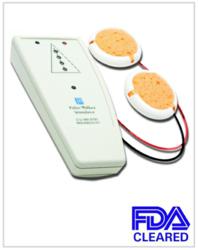Fisher Wallace Laboratories Announces Novel Therapy May Improve Gait and Balance of Parkinson's Patients
Cranial Electrotherapy Stimulation Could Reduce The Risk Of Injury From Falling And Other Movement Related Accidents

New York, NY (PRWEB) June 04, 2012
Conducted by a team of researchers led by Gad Alon, PT, PhD at the Department of Physical Therapy & Rehabilitation at the University of Maryland School of Medicine, the study found that gait velocity and stride length increased in Parkinson’s patients who received the therapy, which may reduce the risk of injury from falling and other movement related accidents, and lead to an improved quality of life for patients with Parkinson’s disease.
Ten patients participated in the pilot study to ascertain the safety and ability of CES, also known as tPCS, to modify protective stepping and gait of individuals with Parkinson’s disease. The participants received three therapies: 1) one treatment of a CES delivered current for 20 minutes; 2) walking on treadmill for 20 minutes; and 3) a combination of CES and treadmill for 20 minutes. One CES session increased stride length and gait velocity significantly compared with treadmill alone, or CES and treadmill combined, suggesting that multiple treatments of CES might yield even better gains.
The Fisher Wallace Stimulator, the CES device used in the study, has been FDA-cleared since 1991 to treat depression and anxiety—two common co-morbid symptoms in Parkinson's patients. The benefit of using one low-cost device to treat movement and mood disorders in Parkinson's patients is significant, and promising. The drugs currently used to treat Parkinson's patients come with serious side effects, and deep brain stimulation (DBS)-- the medical intervention of choice for improving motor control in Parkinson’s disease-- has such strict criteria surrounding its use that it excludes most Parkinson’s patients.
The University of Maryland study is among a growing body of evidence for the safe and effective use of non-pharmaceutical therapies like the Fisher Wallace Stimulator for treating a host of illnesses including post-traumatic stress, acute depression and chronic pain.
About Fisher Wallace Laboratories
Founded by Charles Avery Fisher, the son of stereo pioneer Avery Fisher, Fisher Wallace Laboratories manufactures the Fisher Wallace Stimulator, a cranial electrotherapy stimulation (CES) device cleared by the FDA for the treatment of depression, anxiety and insomnia. The device costs between $495 and $695 and may be purchased online after faxing or emailing written authorization from any licensed healthcare provider, such as a psychologist, nurse, acupuncturist, general practitioner or chiropractor. Fisher Wallace Laboratories continues groundbreaking research at Harvard Medical School, Columbia Medical School, Massachusetts General Hospital, NYU Medical Center and the University of Maryland. The company's devices are made in the USA.
http://www.fisherwallace.com/
http://www.prweb.com/releases/2012/parkinsonsresearch/prweb9567745.htm

No comments:
Post a Comment